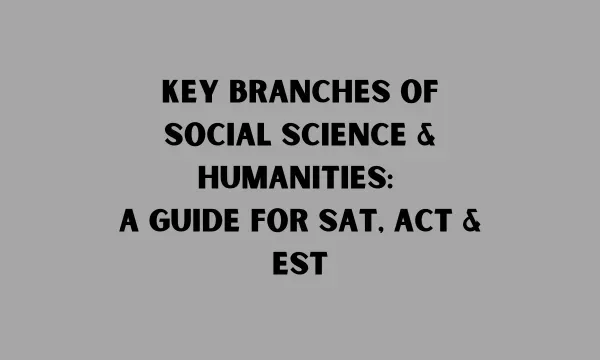Key Branches of Social Science & Humanities: A Guide for SAT, ACT & EST
Introduction
Gaining exposure to the main branches of social science and humanities is beneficial preparation before taking the SAT, ACT, or EST exams. This post explores core disciplines like anthropology, archaeology, economics, and sociology. Understanding these fields equips you with the essential knowledge to tackle social science/humanities-related questions on test day.
Key Branches of Social Science & Humanities: A Guide for SAT, ACT & EST
- Anthropology – The study of human cultures, behaviors, languages, biological/societal origins, and development. Major subfields include cultural, linguistic, archaeological, and biological anthropology.
- Archaeology – The study of human history and prehistory through excavation and analysis of artifacts and materials. Archaeologists uncover and interpret material evidence to shed light on past cultures.
- Economics – The social science focused on the production, distribution, and consumption of goods and services. Microeconomics examines individuals and businesses while macroeconomics looks at economies more broadly.
- Ethnography – The systematic study of individual cultures to document and understand their practices, beliefs, relationships, and norms. Based on intensive fieldwork like observation and interviews.
- Folklore – The collection and study of traditional art, stories, myths, customs, jokes, songs, tales, and more that circulate among groups of people. Examines cultural practices passed down.
- Sociology – The study of social relationships, organizations, and institutions. Sociologists analyze phenomena like social mobility, inequalities, political movements, race, gender, and networks.
Conclusion
With an overview of these foundational social science and humanities branches, you’ll walk into exam day with the background needed to demonstrate your knowledge. Refer back to this guide while prepping and studying.
<->
FAQs:
Q: How do the social sciences/humanities appear on these standardized tests?
A: Relevant passages, charts, and questions test your grasp of major concepts from these fields.
Q: Which branches are most likely to be covered?
A: Sociology, economics, and anthropology questions commonly appear. Archaeology and folklore may be represented too.
Q: Are there patterns to the related questions?
A: Questions often relate to interpreting theories, data, trends, cultural practices, and the implications of research.
Q: What are tips for mastering these topics?
A: Reading widely about diverse cultures, thinking critically about societies, and practicing questions.
Q: Where can I learn more about these fields?
A: Introductory textbooks, online courses, academic journals, educational videos, museums, and documentaries.
References
- The Princeton Review. (2023). Social Science & Humanities Subject Test. https://www.princetonreview.com/college/social-science-humanities-subject-test
- Kaplan Test Prep. (2023). Humanities and Social Sciences: Overview and Practice. https://www.kaptest.com/study/mcat/humanities-and-social-sciences-overview/
- College Board. (2023). SAT Subject Tests. https://collegereadiness.collegeboard.org/sat-subject-tests
- ACT. (2023). Preparing for the ACT Social Studies Test. https://www.act.org/content/act/en/products-and-services/the-act/test-preparation/social-studies-test-description.html

